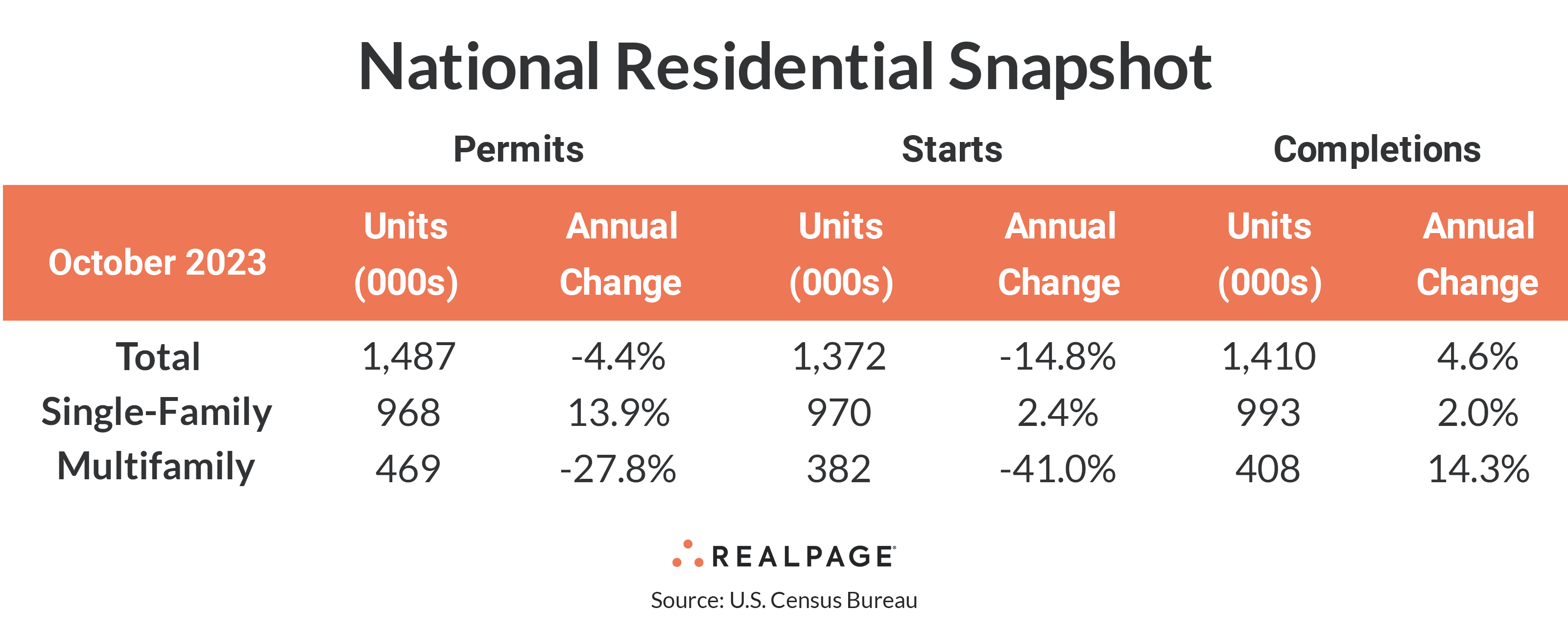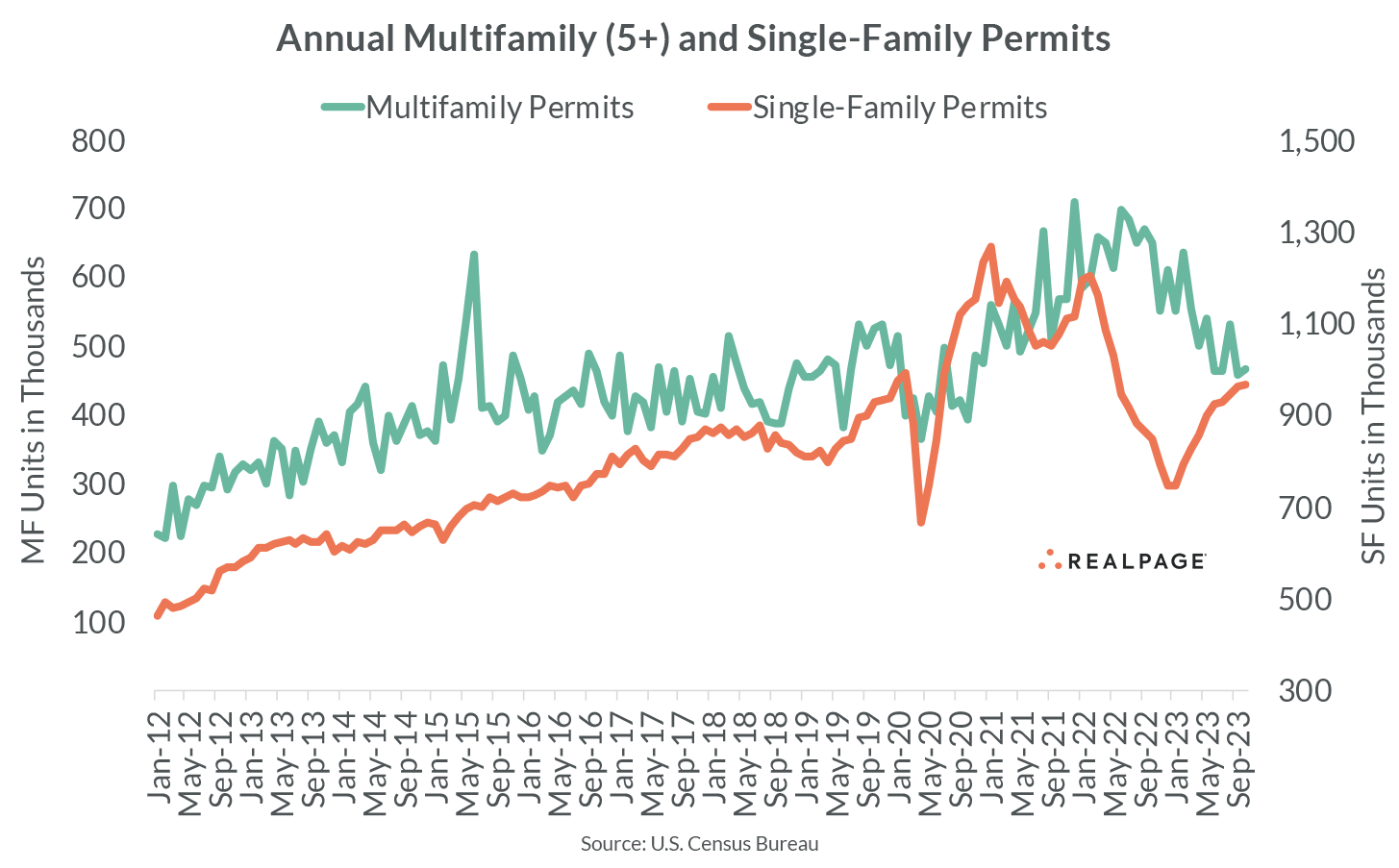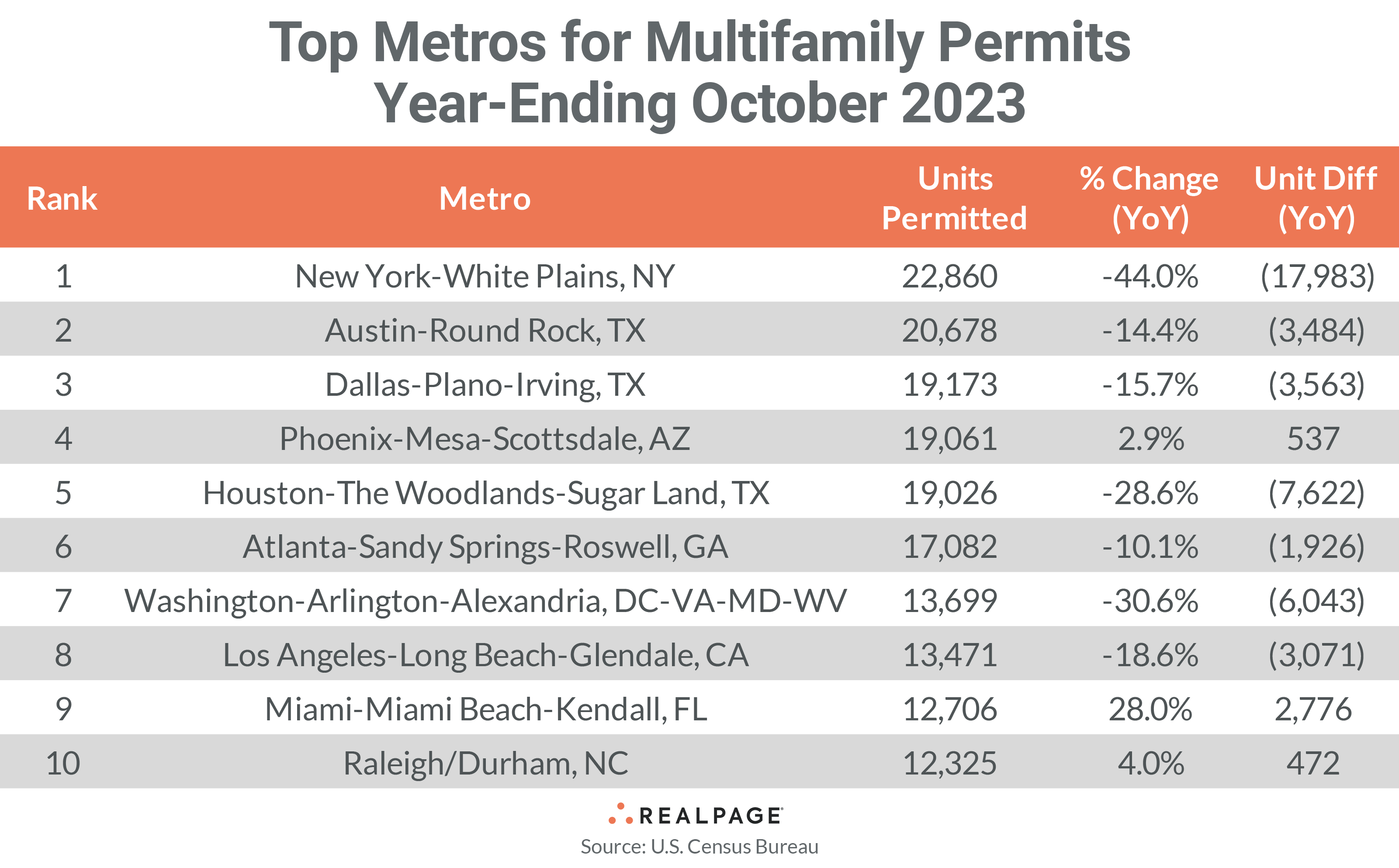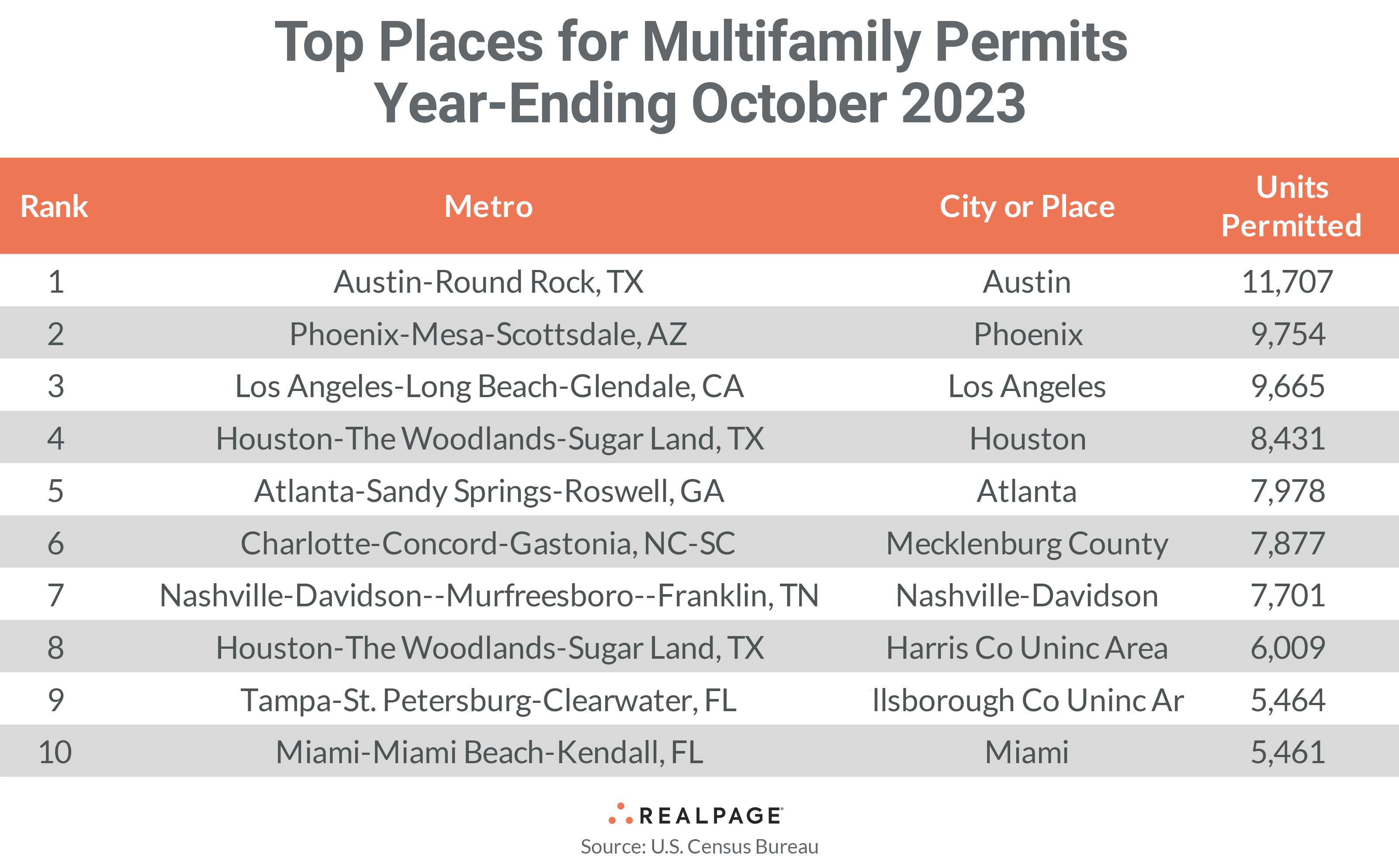Multifamily Development Slows as Single-Family Grows

Editor's note: This blog is part of a monthly series written by RealPage Senior Real Estate Economist Chuck Ehmann in which he examines seasonally adjusted multifamily and single-family starts and permits from the U.S. Census Bureau. Read previous blogs in this series here. RealPage Chief Economist Jay Parsons has called Census data into question, as multifamily starts appear understated in 2022 and overstated in 2023. Read his commentary discussing the validity of those numbers here.
While multifamily permitting and starts continue to decline year-over-year, single-family development is on the rise.
Although up by 4.9% from last month (to 382,000 units), the seasonally adjusted annual rate (SAAR) for multifamily starts declined 31.8% from last October, a much steeper decline than seen in the year-to-date unadjusted starts data. Multifamily permitting fell 27.8% from last year to 469,000 units but that was a slight 2.2% improvement from September.
Meanwhile, the post-pandemic decline in single-family development caused by higher interest and mortgage rates (among other factors) appears to have reversed. The rates for single-family permitting and starts were almost unchanged from last month but were about 13% higher from last year for both at 968,000 permitted units and 970,000 starts.
Completions of multifamily units dipped 12.6% from September to 408,000 units but increased 14.3% from last October as the pipeline continues to empty. The number of multifamily units under construction was unchanged from September at 987,000 units but was up 8.3% from last year. Additionally, the number of multifamily units authorized but not started was up 3.8% at 136,000 units in October but down 9.9% from one year ago.
Single-family completions were down slightly (-0.9%) for the month but were up 2% for the year to 993,000 units. The number of single-family units under construction was essentially unchanged from September’s pace at 669,000 units but that was 14.5% less than one year ago. Single-family units authorized but not started was unchanged from September at 140,000 units but down 4.8% from last year.
The sharp annual decrease in multifamily permitting brought the SAAR of total residential permitting down 4.4% from last October to 1.487 million units and multifamily starts were down 4.1% from last year to 1.372 million units.

Compared to one year ago, the annual rate for multifamily permitting decreased in three of the four Census regions, with the deepest decreases in the Midwest (down 55% to 42,000 units) and South (down 33% to 242,000 units) regions. The West region saw multifamily permitting slow by 15.4% to 131,000 units, while the small Northeast region’s permitting was up 28.3% to 56,000 units. Compared to the previous month, permitting was down in the Midwest and West and up in the South and Northeast.
Multifamily starts fell sharply in the Northeast region (down 74.7% to 10,000 units) and were down significantly in the South (-41.7% to 157,000 units) and West (-40.3% to 91,000 units) regions. The Midwest region saw an increase of 25.9% in starts to 124,000 units. Compared to September’s SAAR, starts were down by about two-thirds in the Northeast and 14% in the South, but up in the remaining two regions.
Metro-Level Multifamily Permitting
All the top 10 markets from September’s list of permit leaders returned in October with four remaining in order. New York continues to lead the nation in multifamily permitting but is still slowing with a total of 22,860 units permitted in the 12-months-ending October, down by almost 18,000 units from last year.
Austin moved up the list to #2 with 20,678 units permitted for the year, up almost 1,100 units from September’s total but 3,484 units less than last year. Dallas slipped to the #3 spot, permitting 19,173 units, also down about 3,500 units from last year and almost 1,900 less than last month.
Phoenix also moved up one spot to #4 with an annual total of 19,061 units, down slightly from September but up 537 units from last October. Houston dropped two spots to #5 with 19,026 units permitted, down about 1,600 units for the month and 7,600 units for the year.
Atlanta, Washington, DC and Los Angeles returned in the #6 to #8 spots, permitting from 13,500 to 17,000 units and down from about 400 to 700 units from September. Miami and Raleigh/Durham switched places at #9 and #10 with Miami permitting 12,706 units to Raliegh/Durham’s 12,325 units. Both were up for the year.
Only three of the top 10 multifamily permitting markets increased their annual totals from the year before and the size of the increases varied from Miami’s 2,776 units to Raleigh/Durham’s 472 units. Of the top 10, New York had the deepest decrease in annual multifamily permitting (-17,983 units), followed by Houston (-7,622 units) and Washington, DC (-6,043 units).
Other major markets with significant declines in permitting include Philadelphia (-11,018 units), Seattle (-8,311 units), Minneapolis/St. Paul (-5,652 units), Denver (-4,899 units), Boston (-3,999 units) and San Antonio (-3,868 units).
In addition to Miami, other major markets with significant year-over-year increases in annual multifamily permitting in the year-ending October were Riverside (+4,716 units), Nashville (+3,755 units), Charlotte (+3,005 units), Greensboro/Winston-Salem (+2,159 units) and Cape Coral-Fort Myers, FL (+1,471 units).
The annual total of multifamily permits issued in the top 10 metros – 170,081 – was about 19% less than the 209,988 issued in the previous 12 months and down about 3% from last month. The total number of permits issued in the top 10 metros was almost equal to the number of permits issued for the #11 through #33 ranked metros.
Below the metro level, nine of last month’s top 10 permit-issuing places returned to this month’s list with five remaining in the same place and the rest changing places. The list of top individual permitting places (cities, towns, boroughs and unincorporated counties) generally include the principal city of some of the most active metro areas.
In October, the city of Austin remained in the #1 position with 11,707 units permitted, 45 more units than in September. The city of Phoenix moved up three spots to #2 in October with 9,754 units permitted, 973 more than last month. The city of Los Angeles slipped to the #3 spot by permitting 9,665 units, down 82 units from September. The cities of Houston and Atlanta also dropped one spot each with an average of about 8,200 units permitted between them, down an average of about 840 units.
Mecklenburg County (Charlotte) permitted 7,877 units for the year to land at #6 on the list, up 380 units from 2022. The city-county of Nashville-Davidson permitted a total of 7,701 units for the year, up 300 units from last month.
The unincorporated areas of Harris County (Houston) and Hillsborough County (Tampa) took the #8 and #9 spots, permitting an additional 6,009 units to the Houston area and 5,464 units to Tampa’s metro total.
The city of Dallas dropped off the top 10 list, replaced by the city of Miami, which permitted a total of 5,461 units for the year-ending October.
With the cities of Dallas and San Antonio dropping off the list of the top 10 permitting places in the past two months, Texas has only three spots this month, while Florida has two and the remaining five spots represent a different state each. Texas has three of the remaining top 20 permitting places and the remainder have one state each.
Following the metro slowing trend (eight out of 10 markets saw a decline in annual permitting from September), six of the top 10 permitting places had fewer annual permits than last month.









